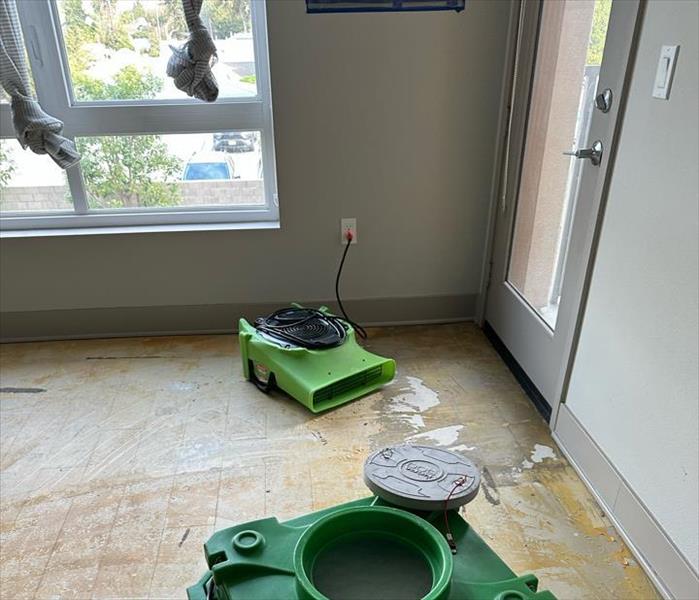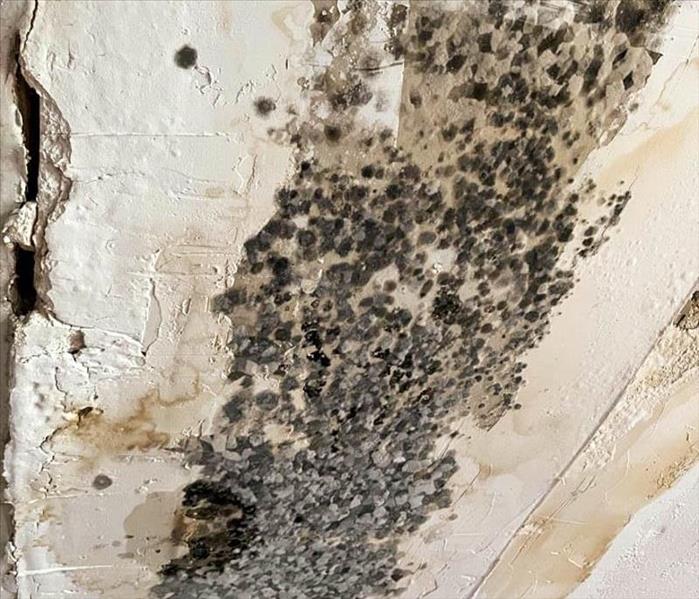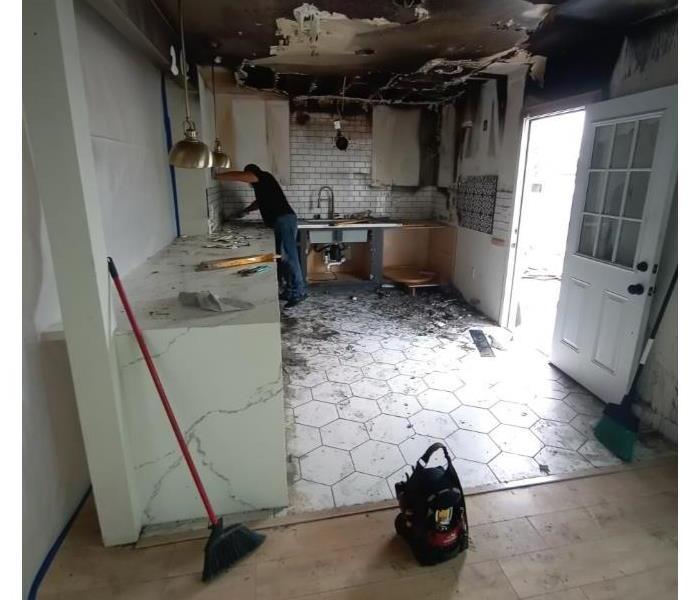Archived Mold Remediation Blog Posts
How Mold Affects Different Types of Flooring: Protecting Your Home with SERVPRO®
11/20/2024 (Permalink)
Mold growth is a serious concern for homeowners, especially when it comes to flooring. Different types of flooring materials respond differently to moisture and mold, and knowing how each is affected can help in preventing long-term damage. Whether you have carpet, hardwood, tile, or laminate, mold can weaken the structural integrity of your home and ruin the appearance of your flooring. Professional mold remediation, such as the services provided by SERVPRO®, is crucial in addressing and preventing further damage. Let’s take a closer look at how mold impacts different types of flooring and what can be done to restore your home.
1. Carpet Flooring
Carpets are highly susceptible to mold growth, particularly if they’ve been exposed to moisture from flooding, leaks, or high humidity. Once moisture seeps into carpet fibers and the padding underneath, it creates an ideal environment for mold to thrive.
- Effects of Mold on Carpet: Mold growth in carpets often leads to discoloration, musty odors, and the weakening of fibers. If left untreated, mold can spread to other areas of the home, making it essential to address the issue as soon as it’s discovered.
- Remediation: In many cases, the affected areas of the carpet and padding may need to be removed and replaced. SERVPRO can assess the damage and provide professional mold remediation, removing contaminated materials and preventing mold from spreading further.
2. Hardwood Flooring
Hardwood floors, while durable, are not immune to mold. If moisture penetrates the wood, mold can grow underneath or within the wood itself. Water can seep through cracks, causing warping, discoloration, and mold growth beneath the surface.
- Effects of Mold on Hardwood: Mold on hardwood can cause the wood to warp, buckle, and lose its aesthetic appeal. It can also spread to the subfloor, complicating the remediation process.
- Remediation: Depending on the extent of the mold damage, the affected wood may need to be sanded, refinished, or replaced. SERVPRO’s experts can assess whether the hardwood can be restored or if more extensive remediation is required.
3. Laminate Flooring
Laminate flooring is a popular choice for homeowners due to its affordability and durability. However, when exposed to moisture, laminate floors are at risk of developing mold between the layers or underneath the surface. Because laminate is not as water-resistant as tile or hardwood, water can easily become trapped underneath, leading to mold growth.
- Effects of Mold on Laminate: Mold under laminate flooring often leads to warping, buckling, and lifting of the floorboards. Mold can also spread to the subfloor, causing structural damage over time.
- Remediation: Removing affected sections of laminate is usually necessary, as moisture and mold can become trapped underneath. SERVPRO’s mold remediation professionals can help assess the extent of the damage and remove or replace the affected flooring.
4. Tile Flooring
Tile flooring is generally more resistant to mold than other materials, but it’s not immune. Mold can grow in the grout between tiles or underneath the tiles if water penetrates through cracks or unsealed areas. Once moisture gets below the tile, it can create an environment where mold thrives.
- Effects of Mold on Tile: While mold doesn’t typically damage the tile itself, it can weaken the grout and spread underneath the tiles, leading to mold growth in hidden areas. This can eventually lead to loosened tiles and structural issues with the subfloor.
- Remediation: SERVPRO can help clean and reseal grout to prevent future mold growth, and if mold has spread beneath the tiles, it may require removal of the affected tiles and remediation of the subfloor.
5. Vinyl Flooring
Vinyl flooring is relatively water-resistant, but like laminate, it can still develop mold if water seeps through seams or edges. Mold often grows beneath the vinyl, where it’s difficult to detect until the damage is significant.
- Effects of Mold on Vinyl: Mold beneath vinyl flooring can cause the floor to bubble, lift, or crack. Once mold spreads underneath, it can affect the subfloor, making it necessary to remove and replace sections of the floor.
- Remediation: In severe cases, the affected vinyl flooring may need to be removed entirely to eliminate mold from the subfloor. SERVPRO’s mold remediation team can remove the mold and replace the damaged flooring.
Why Choose SERVPRO for Mold Remediation
When mold affects your flooring, it’s essential to act fast and seek professional remediation. SERVPRO of Whittier specializes in mold removal and restoration, offering a comprehensive approach to assess, remediate, and restore your home to its pre-damage condition. Our experts have the tools and expertise to handle mold damage on all types of flooring, ensuring your home remains safe and mold-free.
Mold can wreak havoc on your home’s flooring, but understanding how it affects different materials and taking prompt action can minimize damage. Don’t let mold compromise the beauty and integrity of your flooring—contact SERVPRO of Whittier at the first sign of mold.
Mold and Home Energy Efficiency: Finding the Balance
3/13/2024 (Permalink)
 In this blog, we will explore how mold affects home energy efficiency and address mold issues while maintaining an energy-efficient home.
In this blog, we will explore how mold affects home energy efficiency and address mold issues while maintaining an energy-efficient home.
When it comes to maintaining a comfortable and energy-efficient home, many factors come into play. One often overlooked factor is the presence of mold. Mold not only poses potential health risks but can also impact your home's energy efficiency. In this blog, we will explore how mold affects home energy efficiency and provide insights on finding the balance between addressing mold issues and maintaining an energy-efficient home.
Understanding the Impact of Mold on Energy Efficiency
Insulation Reduction: Mold growth can deteriorate the insulation within walls, ceilings, and floors. As a result, the thermal resistance of your home decreases, causing heat transfer and energy loss. This means that your heating or cooling system would have to work harder, resulting in increased energy consumption and higher utility bills.
Air Infiltration: Mold growth often occurs in areas with excess moisture, such as basements, attics, and crawl spaces. These areas are also prone to air leaks, allowing air to enter or escape your home. Mold contamination can exacerbate this issue by creating gaps and cracks, leading to additional air infiltration. Consequently, your HVAC system has to compensate for the temperature imbalances caused by mold, leading to energy wastage.
Dampness and Condensation: Mold thrives in damp environments, which increases the moisture content within your home. This excess moisture can lead to condensation on windows, walls, and ceilings. When left unchecked, condensation can contribute to mold growth and create an energy-draining cycle. Moisture control, alongside mold remediation, is crucial to reducing the energy demands of your home.
Finding Balance: Mold Restoration and Energy Efficiency Tips
Mold Inspection: Regular inspection for mold at home is essential for ensuring energy efficiency. Look for signs of water damage, musty odors, or visible mold growth. Early detection can help prevent extensive mold damage and maintain a comfortable living environment.
Moisture Control: Addressing any sources of excess moisture is vital. Repair leaks, improve ventilation, and use dehumidifiers in areas prone to dampness. By reducing humidity levels, you can inhibit mold growth and create a more energy-efficient home.
Proper Ventilation: Adequate ventilation is crucial for maintaining a balanced indoor environment. Improve ventilation in bathrooms, kitchens, and laundry rooms to control moisture levels and discourage mold growth. Incorporating energy-efficient ventilation systems can enhance both air quality and energy efficiency.
Professional Mold Remediation: If you discover mold in your home, it is important to seek professional mold restoration services. Trained professionals, like SERVPRO®, can properly assess the extent of mold damage and perform effective mold remediation, eliminating the problem at its source. This not only restores your home but also ensures a healthier and more energy-efficient living space.
Mold in Your Home
Mold not only poses risks to your home’s structure but can also impact your home's energy efficiency. By understanding the way mold affects your home and taking preventative measures, you can strike a balance between mold restoration and maintaining a comfortable and energy-efficient living environment. Regular inspections, moisture control, proper ventilation, and professional mold remediation are key steps to achieve this balance. Remember, mold remediation is an investment in both your home's energy efficiency and your peace of mind.
Why is There Mold in my New Home Construction?
11/13/2023 (Permalink)
 Detecting the issue in its infancy can prevent larger problems down the road.
Detecting the issue in its infancy can prevent larger problems down the road.
While a new home should signify a fresh start, there are times when mold unexpectedly makes an appearance. Understanding the reasons behind this occurrence can help you prevent and address the issue effectively. Let's dive into the world of mold in new home construction.
Why Does Mold Develop in New Home Construction?
One of the most common culprits in mold development is moisture intrusion. During the construction process, water exposure can happen in various ways, from rainwater infiltration to plumbing leaks. If not promptly addressed, these moisture sources can create an ideal environment for mold growth.
Despite being new, construction materials can contain moisture. Materials like wood, drywall, and insulation are particularly prone to retaining moisture. If not properly dried or sealed, they can become a breeding ground for mold.
New constructions may not have a well-established ventilation system in place, leading to poor air circulation. This can trap moisture inside the structure, promoting mold growth in hidden areas.
Construction delays can leave the building exposed to the elements for extended periods. Rain and high humidity can affect the integrity of building materials, providing mold spores with the moisture they need to thrive.
Preventing Mold in New Home Construction
To prevent mold during the construction of your new home, start by incorporating mold-resistant materials and design features into your construction plans. Utilize products like mold-resistant drywall and consider proper grading to direct water away from the building.
Its also a good idea to regularly inspect the construction site for any signs of leaks or water damage. Promptly address these issues to prevent moisture intrusion. Consider investing in a robust ventilation system to maintain optimal humidity levels and minimize moisture buildup.
Remember to work closely with contractors to ensure timely construction completion, reducing the exposure of the building to moisture risks!
Addressing Mold in New Home Construction
Detecting the issue in its infancy can prevent larger problems down the road. Conduct thorough inspections during and after construction to spot any signs of mold growth early.
If you discover mold in your new home, contact SERVPRO® of Whittier for professional mold inspection and remediation. Our experienced team can effectively eliminate mold issues and restore your property to its pristine condition!
Mold's unwelcome presence in new home construction can be a puzzling dilemma for homeowners. However, by understanding the factors that contribute to mold growth, you can take proactive steps to prevent its occurrence and ensure your new home remains a healthy, mold-free environment. Our SERVPRO® team is here to assist with any mold-related situation. For more information or to schedule an inspection, get in touch with us today!
Preventing Mold in Your Rental Home: Tips for a Healthy Living Environment
5/8/2023 (Permalink)
Mold is a common problem in rental homes, especially in areas with high humidity or moisture levels. Not only can mold be unsightly and unpleasant, it can cause secondary damages to your property. In this blog, we'll discuss some tips for preventing mold in your rental home.
Control humidity levels
One of the main causes of mold growth is high humidity levels. To prevent mold from growing in your rental home, it's important to keep humidity levels under control. This can be done by using dehumidifiers or air conditioners in areas with high humidity, such as bathrooms and kitchens.
Fix leaks promptly
Leaks in pipes, roofs, or windows can create the ideal environment for mold to grow. It's important to fix any leaks promptly to prevent moisture buildup and mold growth. Make sure to check for leaks regularly, and address them as soon as you notice them.
Ventilate properly
Proper ventilation is key to preventing mold growth. Make sure that bathrooms, kitchens, and laundry rooms are properly ventilated, either through an exhaust fan or by opening a window. This will help to reduce moisture buildup and prevent mold growth.
Clean regularly
Regular cleaning can also help to prevent mold growth in your rental home. Be sure to clean bathrooms and kitchens regularly, paying special attention to areas where moisture tends to accumulate, such as shower stalls and sinks. Use mold-resistant products when cleaning, and make sure to dry surfaces thoroughly after cleaning.
Keep clutter to a minimum
Clutter can trap moisture and create an ideal environment for mold growth. Keep your rental home free of clutter, especially in areas where moisture tends to accumulate, such as basements and closets.
Use mold-resistant materials
When renovating or repairing your rental home, consider using mold-resistant materials. This can include mold-resistant drywall, paint, and insulation. These materials are designed to resist moisture buildup and prevent mold growth. These materials are made to hold up longer to normal wear and tear.
In conclusion, preventing mold in your rental home is an important part of maintaining a safe and healthy living environment. By controlling humidity levels, fixing leaks promptly, ventilating properly, cleaning regularly, keeping clutter to a minimum, and using mold-resistant materials. If you do notice mold in your rental home, it's important to address it promptly and seek the help of a professional mold remediation service if necessary. Give SERVPRO of Whittier a call for your mold remediation and clean up. Our crews are ready to respond anytime, 24/7/365.






 24/7 Emergency Service
24/7 Emergency Service

